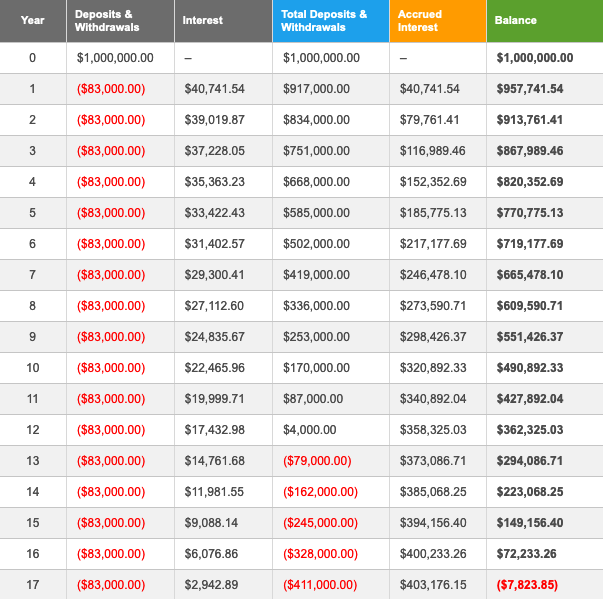“A healthy nest egg can provide a solid foundation for a fulfilling retirement, allowing you to pursue your dreams and create lasting memories.”
This quote highlights the promise of the “nest egg” approach to retirement perfectly. We’re talking about the traditional model that’s been widely accepted since the early 1980s.
This approach says that we should pour our savings into financial assets to work up to this mythical retirement number.
The idea is that we build financial assets and hope our returns get us up to a big enough number that we can live comfortably in retirement. Then, we draw down our assets to create income for ourselves after we quit working.
That is to say, we sell off our stocks and funds and use that money to live on.
The problem is, this approach puts us on a see-saw. It forces us to choose between assets and income. When our assets are going up, we don’t have the income. Then when we want the income, our assets have to come down.
Plus, this model pits us squarely against the tax code. It doesn’t matter if our financial assets are in 401(k)s, IRAs, or regular brokerage accounts—they are going to get taxed in the end.
I’d like to use an example to illustrate just how fragile this is.
Let’s assume we work up to $1 million dollars. Just for easy numbers. We get to retirement with a million-dollar nest egg—plus, we have a little Social Security money coming in. So we say, “You know what, I want to draw $70,000 a year from my nest egg to live comfortably. That will supplement my Social Security”.
Keep in mind, to get that $70,000 we have to sell our financial assets. Which means we have to pay taxes on the proceeds.
Now, let’s assume a conservative tax rate of 15 percent. At that rate, we have to sell about $83,000 worth of assets to get our $70,000 in income for the year. The other $13,000 goes to taxes.
To keep our example here simple, let’s assume our tax rate stays the same for the rest of our life. If we run the numbers, that means we can sell $83,000 worth of assets each year for exactly twelve years. That’s it. After twelve years, we are out of money.
But wait a minute… sharp readers may point out that I’m assuming no return on investment in this example. That’s correct. But I have bad news for you – it doesn’t get much better.
Let’s suppose we can generate a consistent 4% annual return on our $1 million nest egg. If we can pull this off – without having any down years – then we’ll only have gone through about half our nest egg after ten years.
After that we’ll have seven more years to burn through the rest. By Year Sixteen we’ll only have $72,000 left. By Year Seventeen, we’re completely broke.
The following graphic shows the calculations:

To be fair, we’ll be far more comfortable with our finances for a little while in this scenario. That’s because our nest egg will produce over $20,000 a year in interest income for us for ten years.
But notice how it snowballs in the wrong direction after that. It quickly gets to the point where we can’t afford any emergencies. We can’t afford to really do anything but just try to maintain our standard of living.
To me, this makes no sense. Not when there’s a better way.
If all we are really trying to do here is make sure we have enough income to live on in retirement, why take the round-about way to income? Why not just build the income streams in our working years?
Personally, I would rather have assets and income. And I would like my income to go up when my assets go up. I want the two on the same team.
And that’s exactly what rental real estate can do for us. More on that tomorrow…
-Joe Withrow
P.S. Don’t forget that we’ll be opening the doors of our investment membership The Phoenician League very soon. This will be just the third time we’ve accepted new members since we launched last year.
If you’re interested to learn more about what we’re doing, you can do so right here: The Phoenician League Waiting List